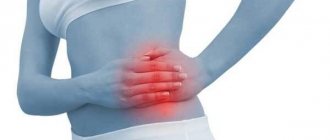Ectopic pregnancy
Short description
An ectopic pregnancy is defined as a pregnancy occurring outside the uterine cavity. The fertilized egg is most often attached to the wall of the Fallopian tubes (tubal pregnancy), less often to the wall of the abdominal cavity or to the ovary. Stitching pain in the lower abdomen may indicate that an ectopic pregnancy has developed; a normal intrauterine pregnancy should not normally cause pain. For medical help, you should contact a gynecologist.
A tubal pregnancy can lead to a ruptured tube.
Localization of pain
Stitching pain in the case of an ectopic pregnancy will be localized in the lower abdomen, to the left or right of the pubic symphysis, depending on which Fallopian tube implantation will occur. If the embryo was implanted on the left, then there will be pain in the lower abdomen on the left in women. The pain increases with palpation of the area where the fertilized egg is attached.
Additional symptoms
An ectopic pregnancy is accompanied by the same symptoms as an ordinary one: menstruation disappears, nausea appears, and the mammary glands become enlarged. When examined on the speculum by a gynecologist, a cyanotic tint of the mucous membrane of the cervical canal and vagina is noted. The cervical canal and the body of the uterus are of soft consistency. In the zone of attachment of the embryo, a formation resembling dough is palpated.
The uterus may be slightly enlarged, but the enlargement will be less than expected for the expected gestational age.
Diagnostics
- Ultrasound (transvaginal),
- assessment of the level of hCG in the patient’s blood (the level of the hormone will be lower than expected at one time or another),
- laparoscopy.
Treatment
- therapeutic and diagnostic laparoscopy: tubotomy or tubectomy.
- if the tube ruptures, salpingotomy is indicated.
When a visit to the doctor should not be delayed
A visit to the doctor for pain in the lower abdomen and chest cannot be postponed when such symptoms occur constantly. If it is confirmed that the pain is associated with the menstrual cycle, the doctor will recommend effective painkillers. When diagnosing more serious pathologies, complex drug therapy is carried out.
It is important not to put off visiting a doctor if your pain continues to worsen. This may be evidence of the development of cancer. In addition, you need to undergo all the necessary examinations when, against the background of pain in the lower abdomen, there are pulling sensations in the chest that radiate to the armpits. This is often a sign of mastopathy.
Mastitis
Short description
Mastitis refers to inflammation of the mammary glands. The process can potentiate the formation of diffuse purulent inflammation (phlegmon), and abscess formation and necrotization of the gland may occur. There is a possibility of developing septic shock, which can be fatal. Mastitis most often develops during lactation. You should be wary of pyogenic microflora getting into the milk, so it is advisable to stop feeding.
The gland may become deformed, which increases the risk of developing carcinoma.
Nature of pain
Mastitis is characterized by intense chest pain of a bursting nature. Local lumps form in the mammary gland, painful when pressed.
Beginning of menstruation
Short description
Quite often, the onset of menstrual bleeding is accompanied by pain in the chest and lower abdomen. Why does my lower abdomen hurt? Pain in the lower abdomen is caused by spasms of the uterine muscles. Why does my chest hurt? Breast pain is explained by its swelling and hardening due to the release of estrogen in the second phase of the menstrual cycle.
If the onset of menstruation is painful, you should seek help from a gynecologist.
Nature of pain
Chest pain is constant, and the pain intensifies with palpation. The pain in the lower abdomen is cramping, the pain syndrome occurs in waves, sometimes intensifying, sometimes subsiding.
Other symptoms
The mammary glands increase in size and their sensitivity increases. Women are more exposed to stress factors than usual and are more irritable.
The onset of menstruation is accompanied by increased fatigue, apathy, and mood lability.
Diagnostics
To diagnose this condition, the patient’s medical history and gynecological examination are sufficient.
Treatment
- combined oral contraceptives (JES),
- antispasmodics (Drotoverine),
- sedatives (leonwort tincture, Novopassit).
Why does my chest and stomach hurt?
Many young girls experience stomach and chest pain during menstruation. But this is not the only reason for the manifestation of such symptoms.
Similar sensations may accompany the following conditions:
- pregnancy period;
- diseases of the mammary glands;
- pathologies of the reproductive system;
- hypothermia of the body;
- lack of nutrients;
- constant stress and depression.
In some situations, consulting a doctor is not required. This is, for example, if you know that your period is coming soon, and painful sensations are their harbinger.
But if your period has long passed, and the next one is still far away, you should think about your health, visit specialists, and get tested.
Endometriosis
Short description
Endometriosis involves the growth of benign tissue. The structure of the overgrown tissue is similar to the uterine endometrium (the inner layer of the uterus). The disease is considered chronic. The main symptom is permanent pain. Usually, after surgical removal of the area of endometriosis, the symptoms disappear and the woman can become pregnant.
It is necessary to consult a gynecologist.
Nature of pain
The pain is stabbing in nature and localized in the lower abdomen. The pain syndrome worsens after the end of menstrual bleeding and during it. Patients complain of pain during sexual intercourse and when urinating.
Additional symptoms
Bloody discharge from the genital tract is characteristic. The volume of discharge is scanty and has the color of dark chocolate. Menstrual bleeding in patients suffering from endometriosis is prolonged and heavy.
When newly formed tissue grows into the wall of the rectum or into the wall of the bladder, traces of blood can be found in stool and urine.
Diagnostics
- Ultrasound (transvaginal, transrectal),
- MRI,
- hysteroscopy,
- colposcopy,
- laparoscopy.
After intercourse
Another fairly well-known and trivial reason why there is pain and aching in the lower abdomen after sexual intercourse may be a special biological structure given to a woman simply by nature. In this situation, pain does not appear in all cases, but when a man and woman take a specific position during sex. It is then quite possible to eliminate these symptoms; you just need to find special positions for yourself that will not cause pain to the woman.
Presence of cystic formations
Short description
Ovarian cysts are tumor-like formations and are false tumors. Cysts are dangerous because they can reduce fertility (the ability to get pregnant). IMPORTANT Although cysts are benign, a combination of factors can cause them to become malignant.
It is necessary to consult a gynecologist.
Nature of pain
When ovarian cysts appear, women experience pain in the lower abdomen. Its nature and severity can vary widely. The intensity of pain depends on the size of the cyst. Small cysts may not cause any discomfort at all, while large cystic formations are accompanied by severe pain.
Other symptoms
Sometimes women are worried about general malaise, and their temperature may increase slightly.
In general, ovarian cysts do not cause significant clinical symptoms.
Diagnostics
- Ultrasound of the pelvic organs (transvaginal): visualization of cystic formation,
- MRI: visualization of the cyst,
- Laparoscopy (diagnostic).
Treatment
- Combined oral contraceptives (Dimia),
- Hormonal agents (Dydrogesterone),
- Surgical laparoscopy.
Preventative measures to avoid nipple pain
To prevent the appearance of discomfort in the nipples, it is recommended:
- reduce the amount of caffeine consumption;
- minimize fat intake, their amount should not exceed 15% of total calories;
- choose a comfortable bra made from natural fabrics, preferably a sports bra;
- apply an anesthetic gel locally, usually such drugs are made on the basis of non-steroidal anti-inflammatory drugs;
- enrich your diet with multivitamins, special attention should be paid to vitamin E.
Proctosigmoiditis
Short description
Proctosigmoiditis is a chronic inflammatory pathology, the process is localized in the area of the intestinal mucosa, namely the rectum and sigmoid colon. This pathology is presented as the most common manifestation of colitis. The disease tends to recur. Along with proctosigmoiditis, inflammation develops in other parts of the digestive tract (gastroenteritis and enteritis).
If you suspect proctosigmoiditis, you should seek help from a proctologist.
Localization of pain
The pain is stabbing in nature and is most often localized in the lower abdomen. An increase in the intensity of the pain syndrome occurs after the act of defecation. Often the pain radiates to the sacral or coccygeal region.
Additional symptoms
Other symptoms of proctosigmoiditis include:
- intoxication of the body,
- fever,
- myalgia,
- general malaise,
- tenesmus (imperative urge to defecate),
- feeling of incomplete bowel movement after bowel movement,
- feeling of a foreign object in the intestines,
- impurities in stool in the form of blood and mucus,
- constipation,
- nausea.
Diagnostics
- rectoscopy is the “gold” standard of diagnosis,
- cytological examination of intestinal contents,
- stool culture,
- biopsy of the intestinal mucosa.
Uterine prolapse
Short description
Prolapse of the uterus occurs due to inferiority of the muscles of the pelvic floor. The pelvic floor muscles are necessary for the pelvic organs to remain in place. If it weren't for these muscles, pressure inside the abdominal cavity would push the organs down. Uterine prolapse is a common gynecological pathology that has difficulties in differential diagnosis.
The extreme degree of uterine prolapse is when it falls out of the vagina, in which case the situation can only be corrected through surgery.
Nature of pain
The process is characterized by nagging pain in the lower abdomen. There is a permanent aching pain in the lower abdomen. When sitting for a long time, the pain increases. When changing position, the pain subsides somewhat. The pain radiates to the sacral and lumbar regions. The pain syndrome is aggravated by physical activity and coitus.
Other symptoms
Disturbances in urination and defecation occur. For prolapse of the uterus, a frequent urge to urinate, a feeling of bladder fullness, and constipation develop. Women feel the presence of a foreign body inside the vagina, this is explained by swelling of the uterus. The walls of the vagina descend and turn outward. There is bloody discharge from the genital tract.
When the uterus prolapses, the menstrual cycle is disrupted.
Diagnostics
- vaginal examination by a gynecologist,
- Ultrasound of the pelvic organs (transvaginal, transabdominal),
- hysterosalpingoscopy,
- computer topography.
Treatment
- Exercise therapy to strengthen the muscles of the pelvic floor (Kegel exercises),
- massage (gynecological),
- decreased physical and sexual activity,
- HRT (hormone replacement therapy) using estrogens to strengthen ligaments,
- surgical intervention is performed in case of significant prolapse of the uterus (vaginoplasty, colporrhaphy, plastic surgery with allomaterials are performed).
Normal state of the body
Everyone knows that women experience menstruation every month; they can appear until a certain age. If a woman has a normal menstrual cycle, this helps her to conceive a child if she wants to become a mother in the future. For some women, their critical days pass with pain. This is due to the fact that they eat a lot of cold foods, dress inappropriately for the weather, or catch a cold on the ovaries due to hypothermia, and for other reasons.











